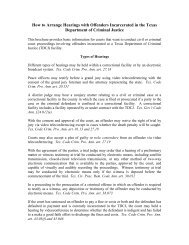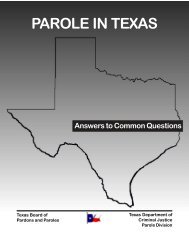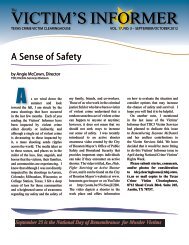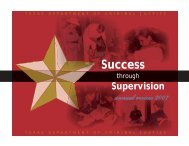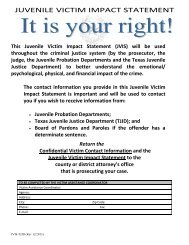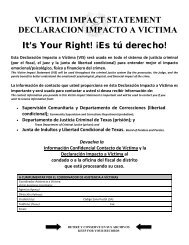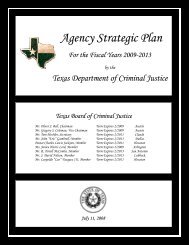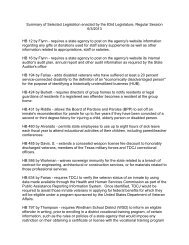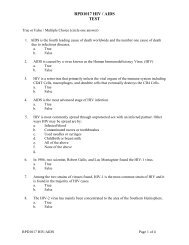Texas Department of Criminal Justice: Reentry Update
Texas Department of Criminal Justice: Reentry Update
Texas Department of Criminal Justice: Reentry Update
- No tags were found...
You also want an ePaper? Increase the reach of your titles
YUMPU automatically turns print PDFs into web optimized ePapers that Google loves.
<strong>Texas</strong> <strong>Department</strong> <strong>of</strong> <strong>Criminal</strong> <strong>Justice</strong>:<strong>Reentry</strong> <strong>Update</strong>September 1, 2012
TDCJ<strong>Reentry</strong> <strong>Update</strong>TEXAS BOARD OF CRIMINAL JUSTICEP. O. Box 13084Austin, <strong>Texas</strong> 78711Phone (512) 475-3250Fax (512) 305-9398Mr. Oliver J. Bell, ChairmanHouston, TXMr. Tom Mechler, Vice-ChairmanAmarillo, TXMr. John “Eric” Gambrell, MemberHighland Park, TXJudge Larry Gist, MemberBeaumont, TXMr. R. Terrell McCombs, MemberSan Antonio, TXMr. Leopoldo R. Vasquez III, SecretaryHouston, TXMs. Carmen Villanueva-Hiles, MemberPalmhurst, TXMs. Janice Harris Lord, MemberArlington, TXMr. J. David Nelson, MemberLubbock, TX<strong>Texas</strong> <strong>Department</strong> <strong>of</strong> <strong>Criminal</strong> <strong>Justice</strong>Brad Livingston, Executive DirectorBryan Collier, Deputy Executive DirectorDee Wilson, Director<strong>Reentry</strong> and Integration Division1
Table <strong>of</strong>ContentsTABLE OF CONTENTS3 Introduction4 Offender Demographics5 <strong>Reentry</strong> Task Force6 Role <strong>of</strong> the <strong>Reentry</strong> Task Force7 <strong>Reentry</strong> Task Force Recommendations14 TDCJ <strong>Reentry</strong> Initiatives16 HB 216118 Summary2
TDCJ<strong>Reentry</strong> <strong>Update</strong>INTRODUCTIONDuring the past two legislative sessions, the state’s Leadership has demonstrated a continued commitment toenhancing the reentry practices at the state and local levels <strong>of</strong> government. During the 81 st Legislativesession, the <strong>Texas</strong> Legislature enacted several policy initiatives designed to develop a more comprehensivereentry process for <strong>of</strong>fenders involved in the adult criminal justice system. Those policy measures includedthe enactment <strong>of</strong> HB 1711, HB 2161 and new funding to create sixty-four (64) reentry case managementpositions within the <strong>Texas</strong> <strong>Department</strong> <strong>of</strong> <strong>Criminal</strong> <strong>Justice</strong> (TDCJ).Although recent budget reductions have impacted reentry initiatives as well as other aspects <strong>of</strong> the agency’soperations, the 82nd Legislature continued funding for sixty-four (64) case manager positions. Ongoingfunding for these critical positions allowed TDCJ to maintain its momentum in providing targeted reentryservices to those <strong>of</strong>fenders determined to be at highest risk <strong>of</strong> recidivism.During the past fiscal year, TDCJ has been involved in the Sunset Review process. As a result, a number <strong>of</strong>recommendations regarding the agency’s and states’ reentry practices were included in the report to theSunset Commission. Those recommendations included the following:1. The agency should develop a reentry plan in accordance with HB 1711;2. The Individual Treatment Plan (ITP) should be revised to provide substantiveinformation regarding the <strong>of</strong>fenders treatment and programming for the Board <strong>of</strong>Pardons and Paroles in their decision making process;3. The <strong>Reentry</strong> Task Force membership should be expanded to include key stakeholdersin the reentry process; and4. The agency’s reentry case management program should be focused on certain<strong>of</strong>fender population and activities.These and other implementation activities are discussed in more detail in the following sections <strong>of</strong> thisreport.3
TDCJ<strong>Reentry</strong> <strong>Update</strong>OFFENDER DEMOGRAPHICSAccording to a 2008 report by the Pew Foundation, 1 out <strong>of</strong> 22 Texans were under some form <strong>of</strong>supervision in the state’s criminal justice system. Four years later, a comparable number <strong>of</strong> <strong>of</strong>fenders areinvolved in the state’s criminal justice system. This number includes the following <strong>of</strong>fender populations:• One million plus <strong>of</strong>fenders are processed in local jails on an annual basis;• 414,000 <strong>of</strong>fenders on misdemeanor or felony probation;• 154,000 <strong>of</strong>fenders incarcerated in TDCJ facilities; and• 83,000 <strong>of</strong>fenders on parole.The combined total <strong>of</strong> <strong>of</strong>fenders under TDCJ’s direct jurisdiction (probation, prison, parole) isapproximately 651,000. Based upon the most recent data reports, <strong>Texas</strong> has the country’s largest criminaljustice population. When coupled with the sheer size <strong>of</strong> the state, providing comprehensive reentry servicesfor 1 out <strong>of</strong> 22 Texans is not the sole role and responsibility <strong>of</strong> one agency, but rather a collaborativeapproach between local and state entities.An important component <strong>of</strong> HB 1711 requires TDCJ, in cooperation with the Office <strong>of</strong> CourtAdministration, to create an eight (8) member <strong>Reentry</strong> Task Force (RTF) to coordinate the development <strong>of</strong>a statewide reentry process. Due to the size and scope <strong>of</strong> the challenge, the agency expanded themembership from 8 to 22 members.4
TDCJ<strong>Reentry</strong> <strong>Update</strong>The size and scope <strong>of</strong> reentry issues requires a multi-agency approach to address the many reentry needspresented by the <strong>of</strong>fender population. The statewide <strong>Reentry</strong> Task Force (RTF) provides a formalmechanism for local and state stakeholders to guide the discussion on the state’s reentry practices. In orderto comprehensively address all the related reentry issues, TDCJ expanded the legislatively mandated eightmembers to the following twenty-two entities:<strong>Texas</strong> <strong>Department</strong> <strong>of</strong> <strong>Criminal</strong> <strong>Justice</strong><strong>Texas</strong> Board <strong>of</strong> Pardons and ParolesOffice <strong>of</strong> Court Administration<strong>Texas</strong> <strong>Department</strong> <strong>of</strong> Public Safety<strong>Texas</strong> <strong>Department</strong> <strong>of</strong> Family and ProtectiveServices<strong>Texas</strong> Commission on Jail Standards<strong>Department</strong> <strong>of</strong> State Health Services<strong>Texas</strong> Workforce Commission<strong>Texas</strong> <strong>Department</strong> <strong>of</strong> Housing and CommunityAffairsHealth and Human Services Commission<strong>Criminal</strong> <strong>Justice</strong> Coordinator, Urban CountyWindham School DistrictTCOOMMI Advisory CommitteeJudicial Advisory CouncilSheriff’s Association <strong>of</strong> <strong>Texas</strong>Urban County CommissionerRural County Judge<strong>Texas</strong> Inmate Family Association<strong>Texas</strong> <strong>Criminal</strong> <strong>Justice</strong> CoalitionFaith Based Volunteer<strong>Reentry</strong> Coordinator, Urban County<strong>Texas</strong> Juvenile <strong>Justice</strong> <strong>Department</strong>5
TDCJ<strong>Reentry</strong> <strong>Update</strong>ROLE OF THE REENTRY TASK FORCEAs outlined in H.B. 1711, the role and function <strong>of</strong> the <strong>Reentry</strong> Task Force is as follows:(b) The reentry task force established under Subsection (a) may :(1) identify gaps in services for <strong>of</strong>fenders following their release or discharge to rural or urbancommunities in the areas <strong>of</strong> employment, housing, substance abuse treatment, medical care, andany other areas in which the <strong>of</strong>fenders need special services; and(2) coordinate with providers <strong>of</strong> existing local reentry and reintegration programs, includingprograms operated by a municipality or county, to make recommendations regarding theprovision <strong>of</strong> comprehensive services to <strong>of</strong>fenders following their release or discharge to rural orurban communities.Identifying gaps in the reentry service delivery system for urban and rural counties is a fairlystraightforward process. The lack <strong>of</strong> affordable and safe housing, opportunities for meaningfulemployment, timely access to substance abuse and mental health treatment, health care and other basicliving supports have been and continue to be the biggest reentry hurdles in rural and urbancommunities. Some <strong>of</strong> these barriers are due to financial constraints; others are due to local, state orfederal policies that restrict <strong>of</strong>fenders from accessing services due to criminal history or instant <strong>of</strong>fense.The following section provides a brief overview <strong>of</strong> the barriers and possible recommended course <strong>of</strong>actions.6
TDCJ<strong>Reentry</strong> <strong>Update</strong>REENTRY BARRIERS AND RECOMMENDATIONSHousing – Proper Housing is critical component to meaningful participation in the community, yetmany barriers to obtaining housing still exist. Housing restrictions can further isolate individualsand place them in unhealthy and counterproductive environments that ultimately contribute tohomelessness and recidivism. Housing barriers can substantially impede and individual’s ability toreconnect with his or her family and loved ones, making it more difficult to associate with positivesupport groups. In addition to identifying available housing for system involved individuals –fromprobationers to parolees—providing assistance and ensuring placement is essential to successfulreintegration into the community. Unfortunately, many <strong>of</strong>fenders are financially unable to rent orown residences therefore rely on subsidized housing or family support for residential needs. Whilefederal housing restrictions are minimal, local housing authorities are allowed broad discretion bythe federal government in establishing eligibility criteria for persons with a criminal justice history;consequently most have adopted some type <strong>of</strong> exclusionary guidelines for <strong>of</strong>fender populations. Toaddress this and other issues, the following recommendations are <strong>of</strong>fered:• Housing providers, both public and private, should coordinate with TDCJ to identify availablehousing and collaborate to assist <strong>of</strong>fenders in obtaining safe and affordable housing.• Continue to coordinate efforts with community resources and various authorities to target thespecific housing needs <strong>of</strong> veterans, persons with special needs, and those with mental healthissues.• Local housing authorities should be encouraged to consider targeting a certain amount <strong>of</strong>subsidized housing slots for <strong>of</strong>fenders in safe neighborhoods within the community.• Provide tax incentives for landlords or rental associations that will allow <strong>of</strong>fenders to rent inprivately owned properties.• Coordinate with the state housing agency on identifying funding streams or model housingprograms that target <strong>of</strong>fenders for certain residential supports.• Explore opportunities to blend public and private funding to provide more housingopportunities for <strong>of</strong>fender populations.• Every effort should be made to maintain, and to eventually increase, the transitional housingavailable to <strong>of</strong>fenders being released and discharged from incarceration and to encourage andfacilitate direct communication between the providers and <strong>of</strong>fenders whenever possible.7
TDCJ<strong>Reentry</strong> <strong>Update</strong>REENTRY BARRIERS AND RECOMMENDATIONSEmployment – During the 81st legislative session, funding for the Project RIO program waseliminated. As a result, targeted job training and supports for <strong>of</strong>fenders during and afterincarceration were no longer available after August 31, 2011. Another barrier to employment afterrelease is the occupational code restrictions that prevent <strong>of</strong>fenders from acquiring certain licensesor holding certain jobs. Studies show direct links between post-prison employment and loweredrecidivism rates. Besides providing income for immediate needs, employment provides a stabilizingroutine, occupies time that might otherwise be used for illegal activities, develops self-discipline,and enhances former <strong>of</strong>fenders’ self-image and self-esteem. The following recommendations are<strong>of</strong>fered as possible strategies to enhance and expand employment options for <strong>of</strong>fenders:• Tax incentives and bonding programs could be expanded to increase the pool <strong>of</strong> potentialemployers willing to hire or provide paid apprenticeships for <strong>of</strong>fenders.• Review the current occupational code restrictions to determine if exclusions could benarrowed to certain <strong>of</strong>fenses or if possible eliminated.• Expand vocational and training opportunities to incarcerated <strong>of</strong>fenders based on jobmarket demands within local communities or the state.• Continue working on a verification system between the TDCJ and the <strong>Texas</strong> VeteransAdministration to identify <strong>of</strong>fenders who may qualify for targeted vocational and educationalprograms.• Examine opportunities to develop and expand partnerships with educational providers andpotential employers to fill gaps in services and to provide additional resources for individualsreentering the community.8
TDCJ<strong>Reentry</strong> <strong>Update</strong>REENTRY BARRIERS AND RECOMMENDATIONSTreatment and Support Services – Most <strong>of</strong> the people in <strong>Texas</strong> prisons will be released at some point.To create more opportunity for the <strong>of</strong>fender to succeed, to prevent gaps in needed treatment, and to lessenthe risk <strong>of</strong> relapse or potential recidivism, there must be robust treatment options as well as continuitybetween institutional services those <strong>of</strong>fered in the community. The majority <strong>of</strong> individuals involved in thelocal and state criminal justice systems have a substance abuse problem that contributes to their illegalbehavior. Also, routine data matches between the criminal justice and mental health systems show acontinued growth in the number <strong>of</strong> <strong>of</strong>fenders with serious mental illnesses incarcerated in local jails andstate correctional facilities. Identifying individuals with these issues is a critical first step, but providing acontinuum <strong>of</strong> treatment and services is crucial to successful reentry. Recent studies on recidivism ratesdemonstrate positive results for those <strong>of</strong>fenders involved in specialized supervision and treatmentprograms funded by the <strong>Texas</strong> Legislature. The following recommendations could potentially result inbetter outcomes for this <strong>of</strong>fender population:• Encourage all state funded treatment programs to be research driven and evidencedbased. Allocation <strong>of</strong> funds should be based on outcomes and results.• Improve the exchange <strong>of</strong> information related to treatment and needed services.• Create continuity by collaborating with community service providers to <strong>of</strong>ferinstitutional treatment and programming and to ensure that similar services are available to the<strong>of</strong>fender upon release to the community.• Expand the availability <strong>of</strong> and eligibility for targeted mental health and substance abusetreatment programs for <strong>of</strong>fenders.• Examine strategies to maximize Medicaid to <strong>of</strong>fset state costs associated withoutpatient substance abuse and mental health treatment. Enhancing federal revenuewould allow for an expanded number <strong>of</strong> <strong>of</strong>fenders to be served with existing statefunds.• Coordinate with the TCOOMMI Advisory Committee in the development <strong>of</strong> special need<strong>of</strong>fender reentry recommendations to be included in their report to the Legislature in January2013.9
TDCJ<strong>Reentry</strong> <strong>Update</strong>REENTRY BARRIERS AND RECOMMENDATIONSAdditional Support Services — Basic-life skills such as money management, healthy life styles, prosocialdecision making and interpersonal communication also represent critical elements to an <strong>of</strong>fender’ssuccessful reentry into society. Institutional programming and services can provide a foundation for thesebasic skills, however without a comparable level <strong>of</strong> services once released, the outcomes may benegatively impacted. The following recommendations can help enhance and expand basic resources andservices necessary to provide individuals the tools necessary to fully integrate back into the community:• Examine current availability <strong>of</strong> community support services, eligibility requirements andexclusions from participation. Work with local and state public and private providers tominimize or eliminate restrictions that preclude <strong>of</strong>fenders from accessing basic life fromskill supports and services.• Enhance and expand current reentry and continuity <strong>of</strong> care service efforts bydeveloping more formal pre and post release referral processes between the agency andlocal community providers.• Enhance current information sharing processes that have a role in the reentry process.10
TDCJ<strong>Reentry</strong> <strong>Update</strong>REENTRY BARRIERS AND RECOMMENDATIONSFamily and Pro-Social Support Systems – Many <strong>of</strong>fenders come from environments wherecriminal thinking and behavior is the norm. As a result, many <strong>of</strong>fenders have minimal exposure topro-social values and beliefs. TDCJ has over 18,000 volunteers, most <strong>of</strong> them faith-based, who serveas positive role models and support systems for <strong>of</strong>fenders. Unfortunately, a similar level <strong>of</strong>volunteerism does not exist for those same <strong>of</strong>fenders once they are released from custody andreturned to the community. Community involvement in the reentry process should be encouraged asit serves to destigmatize <strong>of</strong>fenders, allowing them to view themselves as valued members <strong>of</strong> society.Pro-social attitudes and behaviors are learned though modeling and positive interactions, makingvolunteers and mentors crucial to the reentry process. The following recommendations will be furtherdeveloped by the RTF during the next biennium:• Recruit volunteers, including ex-<strong>of</strong>fenders, to serve as certified reentry mentors. Faithbasedorganizations <strong>of</strong> different denominations, reflective <strong>of</strong> the diversity <strong>of</strong> <strong>of</strong>fenders andtheir religious preferences, will be recruited and trained to provide individualmentoring and support to the <strong>of</strong>fender AND family on a pre and post release basis.• Coordinate with family associations and other special interest groups on strategies torecruit volunteers or mentors from their respective organizations. Families <strong>of</strong> <strong>of</strong>fenders arean excellent resource to other families who may be struggling with their loved onesincarceration or return to the community.• Identify private funding sources to provide stipends to ex <strong>of</strong>fenders to serve as mentorsto <strong>of</strong>fenders after their release from incarceration. A small stipend could be used to <strong>of</strong>fsettransportation or communication costs incurred by the ex <strong>of</strong>fender in their mentoringactivities.• Continue the expansion <strong>of</strong> faith-based dorms <strong>of</strong> different denominations to include anintensive focus on pre and post release reentry planning and supports.• Continue to work with the Attorney Generals <strong>of</strong>fice on child support issues, and its potentialimpact on the <strong>of</strong>fenders reentry to the community.• Strengthen the interactions between criminal justice agencies and the <strong>Department</strong> <strong>of</strong> Familyand Protective Services to improve their respective interventions with mutual clients.12
TDCJ<strong>Reentry</strong> <strong>Update</strong>OTHER REENTRY BARRIERS AND RECOMMENDATIONSIn addition to these reentry service barriers, there are other challenges that impact the state’s effortsto improve the reentry process in <strong>Texas</strong>. During the upcoming biennium, the agency in cooperationwith its local and state partners will continue to coordinate our individual and collective efforts toestablish a comprehensive and seamless reentry process within the state <strong>of</strong> <strong>Texas</strong>. To accomplish thisworthwhile goal, the following recommendations are <strong>of</strong>fered for consideration:• Examine strategies to improve information sharing among local and state agencies. Therecontinues to be considerable duplication <strong>of</strong> effort among staff due to conflicting laws oradministrative practices that unintentionally create barriers to communication and datasharing.• Examine opportunities to promote cross-training and certification <strong>of</strong> staff to perform certainfunctions <strong>of</strong> other agencies. This strategy could result in improved reentry processes forissuing birth certificates, the renewal <strong>of</strong> driver’s license or state identification cards and timelyaccess to federal entitlements for eligible <strong>of</strong>fender populations.• Expand efforts to engage <strong>of</strong>fenders in programming and treatment services during and afterincarceration. Without the <strong>of</strong>fenders willing participation, essential changes in their criminalthinking and behavior patterns is less likely to occur.• Consider establishing state policy similar to TCOOMMI’s continuity <strong>of</strong> care for special needs<strong>of</strong>fenders for ALL <strong>of</strong>fenders involved in the adult criminal justice system. Requiring local andstate governmental entities to define their individual and collective role and responsibility inthe reentry process would ensure some level <strong>of</strong> accountability for all affected agencies.• Community service and resource information provided to the <strong>of</strong>fender during incarcerationand at time <strong>of</strong> release must be comprehensive and current. The information should be countyspecific,up-to-date, available in Spanish, contain verifiable contact information, and readilyaccessible in unit law libraries and school libraries. The RTF should play a critical role inensuring that service information regarding their respective agencies, associations ororganizations is routinely provided to TDCJ.• Information on state and federal entitlement programs, including eligibility and exclusionarycriteria should be available in all correctional settings, including local jails, probation, prisonand parole <strong>of</strong>fices.13
TDCJ<strong>Reentry</strong> <strong>Update</strong>TDCJ REENTRY INITIATIVESTDCJ, like other states’ adult criminal justice agencies, is implementing research driven and evidencedbased approaches in working with the <strong>of</strong>fender population. Research has proven that targeting <strong>of</strong>fendersassessed as having the highest criminogenic factors and needs will have the most dramatic impact onreducing recidivism and improving public safety. The agency has adopted or is in the process <strong>of</strong>implementing the following evidenced based practices in its day to day operations:• All current and future treatment or interventions must adhere to evidenced basedpractice models;• A new risk and need assessment covering all stages <strong>of</strong> the criminal justice system is beingpiloted in community supervision departments and the <strong>Reentry</strong> Division. The goals is toimplement a uniform assessment toll across the agency to improve consistency in supervision,classification and program assignment <strong>of</strong> <strong>of</strong>fenders on probation, parole or incarcerated inTDCJ correctional facilities;• An integrated casemanagement system is being examined that will record and track <strong>of</strong>fenderprogramming, assessments and progress.• The Individual Treatment Plan (ITP) is being revised in cooperation with the Board <strong>of</strong> Pardonsand Paroles (BPP) to enhance <strong>of</strong>fender programming documentation;• Internal workgroups continue to meet to identify reentry barriers, and make recommendationsfor resolving problems; and• A comprehensive reentry plan is being developed in cooperation with the BPP and the WSD toestablish short and long term goals and objectives for system wide reentry best practices. TheRTF and key community partners will be solicited for their input and recommendations to beincluded in the state’s reentry plan.14
TDCJ<strong>Reentry</strong> <strong>Update</strong>TDCJ REENTRY ISSUESAlthough the past year produced a number <strong>of</strong> positive changes to the agency’s reentry efforts, the overallprogress was impacted by fiscal challenges facing the state during this time period. Due to budgetreductions prior to, during and after the 81 st Legislative session, the agency reduced its workforce by 1044positions. Included in this number was 168 Project RIO staff assigned to correctional facilities to assist<strong>of</strong>fenders in reentry and employment related support services. To minimize the impact <strong>of</strong> the staffreduction, the following interim measures were implemented:• Identification document processing activities have been assigned to other unit based staff such aschaplains and treatment providers. Although the number <strong>of</strong> documents processed during the past yeardecreased, the overall impact was less severe than it would have been.• Prior to the staff reduction, 100% <strong>of</strong> the TDCJ correctional facilities had reentry staffassigned to the units. Today, 48% <strong>of</strong> the units have reentry support staff. To maximize theremaining staff resources, <strong>of</strong>fenders assessed as highest risk are prioritized for reentry services.Priority for reentry services will also be limited to <strong>of</strong>fenders released on some form <strong>of</strong>supervision to ensure compliance to the post-release reentry plan.• Distribution <strong>of</strong> birth certificates, social security cards and other identification documents occursat the <strong>of</strong>fenders’ initial visit with his/her parole <strong>of</strong>ficer rather at time <strong>of</strong> release. This change notonly decreased the amount <strong>of</strong> time reentry staff spent distributing documents during the releaseprocess, but decreased the likelihood <strong>of</strong> the <strong>of</strong>fender losing the documents.15
TDCJ<strong>Reentry</strong> <strong>Update</strong>State Identification Card <strong>Update</strong>During the past year, the TDCJ, <strong>Department</strong> <strong>of</strong> State Health Services (DSHS) and <strong>Department</strong> <strong>of</strong> PublicSafety (DPS) have continued to work on establishing an electronic process for issuing a stateidentification card for all <strong>of</strong>fenders released or discharged from state correctional facilities. Fullimplementation <strong>of</strong> this initiative has not yet been achieved due to a variety <strong>of</strong> policy and funding issues.Despite these issues, the TDCJ has instituted the following interim measures to assist the <strong>of</strong>fender insecuring a state issued identification card after their release to the community:• TDCJ and DSHS have entered into an interagency contract to obtain birth certificates for those<strong>of</strong>fenders who were born in <strong>Texas</strong> and whose driver license/state ID will expire prior to theirrelease. Offenders who are eligible to renew their cards or licenses after release, have pendingfelony detainers or illegal aliens are excluded from the birth certificate application process.• TDCJ has an interagency agreement with the Social Security Administration to provide replacementSocial Security Cards for <strong>of</strong>fenders scheduled for release within six months.• Other supporting identification documents such as military records or <strong>of</strong>fender identification cardsthat may be used to secure a state drivers license or identification card are provided to <strong>of</strong>fenders attime <strong>of</strong> their release.• Offenders who are eligible to renew their state issued drivers license or identification card after theirreturn to the community are provided written notification <strong>of</strong> this status prior to and at the time <strong>of</strong>their release.• TDCJ, DSHS and DPS are in the process <strong>of</strong> finalizing interagency contracts for issuing the stateidentification card through an electronic process. A pilot program for identification cardapplications and processing will be operational in Spring, 2013.16
TDCJ<strong>Reentry</strong> <strong>Update</strong>OTHER REENTRY BARRIERSIn addition to local and state policies that impact reentry, a number <strong>of</strong> federal rules have been cited asbarriers to the process. Prior to 9/11, federal agencies such as the Social Security and VeteransAdministration provided the TDCJ with verified social security number, military status and disabilitybenefit eligibility information on <strong>of</strong>fenders incarcerated in the states correctional facilities. Without a stateissued identification card, the <strong>of</strong>fender will be unable to obtain basic living needs such as renting a house,opening a bank account, applying for a job or accessing entitlement programs. The following provides abrief overview <strong>of</strong> the current guidelines and processes for requesting and obtaining this information andputs forward recommendations that may help overcome some barriers:• The Social Security Administration (SSA) will provide an affirmative or negative response to eachverification request. Unfortunately, if the SS number is not correct, the SSA will only respond with arejection rather than the accurate number. Due to the significant number <strong>of</strong> incorrect numbersprovided by <strong>of</strong>fenders, the agency opted not to pursue this option. The TDCJ is however workingwith the DPS on an alternative strategy for verifying an <strong>of</strong>fender’s SS number.• The TDCJ currently serves as a member <strong>of</strong> the <strong>Texas</strong> Coordinating Council for Veteran Servicessponsored by the <strong>Texas</strong> Veterans Commission. One <strong>of</strong> the key issues the agency is working on withthe council is the accurate and timely identification <strong>of</strong> veterans within the local and state criminaljustice systems. In the past, the agency provided the names <strong>of</strong> all <strong>of</strong>fenders to the VeteransAdministration (VA) for verification <strong>of</strong> the <strong>of</strong>fenders military status. Due to changes in federalsecurity laws, the identification <strong>of</strong> veterans in the criminal justice system is now limited to selfreporting.For those who self-identify as veterans, the agency refers that person to the VA for pre andpost release supports. To further enhance our current identification process, the agency will submit adata report on all <strong>of</strong>fender admissions to the VA in the hope the VA will use the data to identify othereligible veterans who did not self-report veteran status to TDCJ.• State policy requires the TDCJ to initiate the disability benefit reapplication process on any <strong>of</strong>fenderincarcerated in our correctional facilities for 12 months or less. For <strong>of</strong>fenders with mental illnesses orother special needs this is a great strategy for reinstatement <strong>of</strong> benefits prior to release. Unfortunatelythe SSA does not provide the information without a signed release <strong>of</strong> information and self-reportingis less than reliable. TDCJ will continue to work with key health and human service partners towardscreating a more reliable process for identifying <strong>of</strong>fenders who may have received some type <strong>of</strong>federal entitlement service prior to their incarceration. 17
TDCJ<strong>Reentry</strong> <strong>Update</strong>SummarySince the implementation <strong>of</strong> HB 1711 in September 2009, the agency has made considerable progresstowards enhancing reentry practices within the state. Most notably, efforts to adopt and implement auniform risk assessment for the probation, prison, reentry and parole systems is a positive step in the rightdirection. This strategy will ensure that all TDCJ divisions are targeting the appropriate level <strong>of</strong>supervision and treatment to <strong>of</strong>fenders who pose the highest risk <strong>of</strong> recidivism and to public safety.The <strong>Reentry</strong> Task Force’s commitment to improving the coordination between local and state entities onreentry issues will continue to have a positive impact on the states reentry efforts. The RTF recognizesthat the role and responsibility <strong>of</strong> reentry is not solely the function <strong>of</strong> the TDCJ but rather a collaborativepartnership among key public and private stakeholders. Despite the progress, the RTF and agencyacknowledge that significant challenges still exist.Creating a comprehensive reentry process that addresses rural and urban differences, financialconstraints, regulatory barriers and the ever-changing demographics <strong>of</strong> the state is and will continue to bedifficult challenges. The current and proposed recommendations outlined in this report however areintended to provide the TDCJ and its partner with a short and long term plan <strong>of</strong> action towards reducingrecidivism and enhancing the public safety <strong>of</strong> the citizens <strong>of</strong> <strong>Texas</strong>.18





